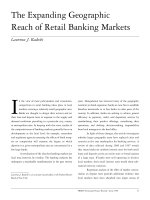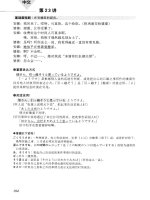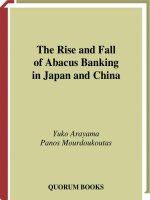The Rise and Fall of Abacus Banking in Japan and China phần 8 pps
Bạn đang xem bản rút gọn của tài liệu. Xem và tải ngay bản đầy đủ của tài liệu tại đây (527.13 KB, 17 trang )
Exhibit 5.8
Bank Assets (1980–1997)
Source: State Statistical Bureau (various years).
The Rise of Abacus Banking in China 119
the Chinese government by and large remains the majority owner of
SOEs and the successors of CEs, township and village enterprises (TVEs).
This means that their board and management are either directly or in-
directly controlled by the Communist Party or national, provincial, and
town governments, which appoint the managers who run them.
Appointed by a Communist Party–selected board, managers’ primary
objective is to maximize ‘‘people’s’’ welfare, that is, the welfare of the
Communist party, the national, state, and local government bureaucrats,
the large number of SOEs, and the surrounding community. Even the
emerging private enterprises and joint ventures are at the mercy of pro-
vincial and local governments, as they must enjoy good relations with
them if they want to be and remain in business.
The same arguments can be made regarding the banking sector, where
bank assets are almost 100 percent owned by the government, compared
to about 30 percent in Argentina and Mexico.
21
As Mookerjee and Peebles
observe: ‘‘During the 1980s and continuing into the 1990s the monetary
system, together with the state industrial sector which it was created to
serve, have remained the least reformed parts of the economy.’’
22
Wei
and Zeckhauser are more emphatic:
For more than a decade, China has been talking about reforming its financial
sector, cleaning up its bad loan problems. Some progress has been made, but far
from enough; reform is painfully slow. It has not seemed urgent, and it is tied
to complex problems of reforming state-owned enterprises.
23
Indeed, in spite of the many financial liberalization measures an-
nounced, the state banking system continued to account for roughly two-
thirds of all financial assets, a figure that is probably much higher if
many of the bank-owned ITICs are included in the calculations (see Ex-
hibit 5.9). In fact, in 1994, there was only one ‘‘privately owned’’ ITIC,
the Shanghai AJ Finance, with RMB 2.4 billion in 1995. In 1997, bank
deposits accounted for almost 80 percent of total bank assets in China,
compared to 60 percent in the United States (see Exhibits 5.10 and 5.11).
And China’s central banking continues to display a mix of an independ-
ent central bank and a central planing instrument, displayed in the tra-
ditional ‘‘operational principles of central planning’’—that is, unified
planning (the central bank rations credit to the banking industry), fund
availability (banking liquidity controls), account division (the independ-
ence of specialized banks from central banking), and interbank lending.
24
In practice, this means that credit planning is still in effect in China,
Exhibit 5.9
Financial Assets Distribution (1986–1994)
Exhibit 5.10
Bank Deposits in China (1980–1997) (percent of total assets)
Exhibit 5.11
Bank Deposits in the United States (1980–1995) (percent of total assets)
The Rise of Abacus Banking in China 123
and the PBC pulls the strings to have it implemented. The PBC, for in-
stance, ‘‘combines all banks’ fund sources and uses, which are aggre-
gated from the banks’ regional branches. The national credit plan
controls credit uses, both quantitatively and qualitatively, by specifying
mandatory annual credit targets.’’
25
In addition, the PBC injects funds to
banks unable to meet loan demand by SOEs and adjusts interest rates to
accommodate credit plan targets. The PBC further continues to control
interest rates that allow banks to earn seigniorage. This means that Chi-
nese banks have a long way to go before they are transformed into sound
financial institutions, as defined by the market. As Melloan observes: ‘‘It
appears that whatever might be happening to the banking system, it
remains a very long way from becoming a financial structure that allo-
cates capital effectively, as banks do in well-run market economies.’’
26
Banks by and large remain government departments, operating within
a central planning environment and promoting the welfare of the ‘‘peo-
ple’’ rather than true enterprises operating in a market system and pro-
moting the interests of their stockholders. As Kime puts it,
China’s state banking system functions essentially as an agency of the govern-
ment, ‘‘selling’’ deposits much as a finance ministry would sell government se-
curities. In effect, one agency of the Chinese government borrows from the
non-state public and ‘‘lends’’ the money to another part of the government, the
state enterprise sector.
27
Bank managers are recruited from the ranks of Party members and gov-
ernment bureaucrats appointed by Communist Party-controlled boards,
and that constrains their freedom to allocate credit according to the prin-
ciples of risk management. Bank managers, therefore, lack the will and
the freedom to assume risks and to adjust their inputs and outputs to
changing market conditions. For instance, they have limited freedom to
evaluate the performance and to even lay off excess labor or introduce
technological processes that may displace labor, as is often the case with
the banks of market economies.
Bank managers have little freedom to allocate credit outside of the
parameters of the credit plan that continues to be biased toward SOEs,
which absorb close to 80 percent of overall credit.
28
Coming from the
ranks of government bureaucrats and the Communist Party rather than
from business schools, Chinese bank managers lack the skills to under-
stand, analyze, and appraise traditional and non-traditional banking
risks. In fact, China has a large shortage of professional managers. After
all, this is the country that for centuries looked down on economics and
124 The Rise and Fall of Abacus Banking in Japan and China
business education, especially during the communist regime, which de-
nounced capitalist management or reduced it to just an engineering op-
eration.
29
Reflecting the attitudes toward business education, the
percentage of economic, finance, and management graduates in the total
number of university graduates declined from an average of 10.3 in the
period 1928–1947 to 2.1 in the period 1966–1976, and it remained at 3.6
in the period 1977–1985.
30
Given these constraints, the rational choice for the government-
appointed managers is to confine themselves to routine and predictable
businesses (i.e., expand the volume of lending rather than the quality of
lending or venture to the genuine and unpredictable business of devel-
oping new products and services). As J. Thomas Macy observed in the
1998 World Forum on Asia, management standards have improved, but
China’s banks, even its best ones, are still way behind their Western
counterparts, particularly in areas such as investment technology. To put
it differently, volume lending rather than quality lending or innovation
has been the business strategy of Chinese banks, a strategy reflected in
the size of China’s banks. In 1945, for instance, with more than $30 billion
in assets and close to $2.5 billion in profits, China’s four state banks—
Bank of China, Industrial and Commercial Bank of China, China Con-
struction Bank, and Agricultural Bank of China—occupied the first four
out of the top ten positions of Asia’s largest banks.
31
To sum up, the Chinese banking industry has always been a tightly
regulated industry, especially during the early communist era, when
government ownership and central planning reduced it to a treasurer of
the Ministry of Finance. But even during the later communist era, even
after the 1978 reforms, banks largely remained under government own-
ership and control, and bankers continued to act as government account-
ants, monitoring the money flows between households and government
departments, rather than as credit risk managers, with two differences.
First, robust economic growth boosted savings and lending to SOEs. Sec-
ond, it made money flows less predictable than before, especially since
corporate clients were exposed to the wild swings of the global economy
in the aftermath of the Asian crisis, an issue that will be addressed in
the next chapter.
NOTES
1. For a detailed discussion, see King (1965).
2. Determined within the central plan, SOE profit is more an accounting
rather than an economic concept.
The Rise of Abacus Banking in China 125
3. Arayama and Mourdoukoutas (1999), p. 49.
4. One could even trace China’s attempt to create a world market frontier
even earlier than that, back to the Han dynasty (206
B
.
C
. to 220
A
.
D
.) and the
construction of the ‘‘Silk Road.’’
5. In fact, China was a founding member of GATT in 1948 but it dropped
out after the communist victory.
6. For a detailed discussion, see Harding (1987), ch. 6.
7. King (1965), p. 97.
8. Ibid., p. 11.
9. Ibid., p. 97.
10. Ibid., p. 20.
11. Lu and Yu (1998), p. 148.
12. Ibid., p. 93.
13. Hsiao (1971), p. 90.
14. Lu and Yu (1998), p. 159
15. Ibid., p. 129.
16. Hsiao (1971), p. 130.
17. Ibid., p. 91.
18. Kime (1998), p. 14.
19. Zhang (1998), p. 1.
20. Yu and Xie (1999), p. 43.
21. ‘‘A Survey of Banking in Emerging Markets,’’ The Economist, April 12, 1997,
p. 12.
22. Mookerjee and Peebles (1998), pp. 152–153.
23. Wei and Zeckhauser (1998), p. 365.
24. Lu and Yu (1998), pp. 150–151.
25. Ibid., p. 151.
26. G. Melloan, ‘‘Asia Revives, but Whither Japan and China?’’ Wall Street
Journal, March 2, 1999, p. A19.
27. Kime (1998), p. 16.
28. Fry (1999).
29. Indeed, China, a country rich in labor, is poor in specialized labor, espe-
cially skilled management.
30. Xu-Yao, Ke-Chun, and Chan-Min (1989).
31. ‘‘A Survey of Banking in Emerging Markets,’’ pp. 5–48.
Chapter 6
The Fall of
Abacus Banking in China
A bank lives on credit. Till it is trusted it is nothing; and when it
ceases to be trusted it returns to nothing.
—Walter Bagehot
1
For almost two decades since the late 1970s, globalization, the increasing
integration and interdependence of world markets, has shown the world
its bright side, especially to the emerging economies of Asia and most
notably to China. It has provided them with a genuine opportunity to
develop themselves. Fewer trade restrictions, for instance, have made it
easier for these economies to sell their labor-intensive products to West-
ern markets. Fewer capital restrictions have allowed foreign investment
to pour into their factories. Lower ideological tensions and improved
international relations allowed communist countries like China access to
Western commodity, technology, and capital markets, which propelled
the country’s robust economic growth, as discussed in the previous chap-
ter.
By the mid-1990s, globalization began to show the world and the econ-
omies of Asia in particular its dark side, that of intensified competition,
price destruction, and declining local currencies. In this sense, globali-
zation has turned from a source of opportunity to a source of uncertainty
that threatens to slow down or even reverse the early gains that these
128 The Rise and Fall of Abacus Banking in Japan and China
countries have made in developing their economies. Globalization has
further turned into a major challenge to the institutions and policies that
for many years have supported the successful entry of these countries
into world markets, especially the banking institutions that have been
enjoying an almost risk-free environment.
Globalization’s dark side is more visible and evident in Asian NIEs
and in Japan, coming off a system of highly protected and regulated
domestic markets that eliminated competition and the risks and uncer-
tainties associated with them. For instance, in Japan, discussed in Part I
of this book, globalization has contributed to the disbanding of the ‘‘es-
corted convoy’’ system and the intensification of domestic competition
that have led to the eventual decline and fall of the abacus banking
system and the banking crisis.
Globalization’s dark side is less visible and less evident in China,
which has been a latecomer to the world economy and therefore under
less pressure to open her economy to foreign products and competition.
Due to a low degree of integration in world markets, as manifested in
the continuing tight currency and interest rate controls, the Chinese econ-
omy seems to have weathered the crisis that ravaged the other Asian
economies. Her currency remained stable, and the conditions for the ab-
acus banking industry, discussed in the previous chapter, remained in-
tact. This also could explain why China has thus far avoided a full-blown
banking crisis.
Yet China has not completely escaped from the Asian crisis. In fact,
even before the Asian crisis began, the country’s economy suffered from
excess capacity, the piling up of inventories, and intensified competition.
Export prices have been falling sharply, and foreign capital flows have
been stalled or even reversed. In addition, China suffers from two fun-
damental problems—the lack of an expanding world market frontier for
her products and the inability to innovate, that is, to turn new technol-
ogies into new products and processes, thus creating sustainable com-
petitive advantages associated with them.
China’s lack of an expanding world market frontier and her inability
to innovate have taken their toll on her economy and her banking in-
dustry in particular, eliminating most of the conditions that supported
and reinforced the abacus banking strategy.
• Commodity prices have been declining.
• Government regulation and protectionism have been weakening.
The Fall of Abacus Banking in China 129
• Economic growth has slowed down.
• The interest rate spread has turned negative.
Arguing these points, this chapter takes a close look at the Chinese
economy since the mid-1990s, especially since the aftermath of the Asian
crisis, and explains how external and internal pressures have been chang-
ing the rules of the game for banks, eliminating most of the conditions
for abacus banking. Specifically, this chapter discusses how a late entry
into the world markets, large size, and social inertia constrain the coun-
try’s ongoing bid for economic development and narrow the horizons
and choices of China’s banking industry, which continue to survive on
seigniorage income.
As discussed earlier, globalization, especially the easing of ideological
tensions and the improvement of international relations between former
socialist countries and the countries of market economies, has offered
China a genuine opportunity to expand her trade and capital flows to
the rest of the world and to develop herself. Indeed, for almost two
decades since the 1978 reforms, foreign investment, technology transfer,
and robust exports have propelled the country’s economy to grow by
leaps and bounds, attracting once again both the fear and the admiration
of China’s nearby neighbors and her faraway trade partners.
2
Yet, as has been the case in the past, the country’s genuine bid to
develop herself has encountered a number of external and internal pres-
sures. External pressures come from China’s lack of an expanding world
market frontier for her products as manifested in rising trade tensions
with her trade partners, most notably with her major trade partner, the
United States, which has been experiencing rising trade deficits (see Ex-
hibit 6.1).
Chinese/U.S. tensions are further manifested in China’s difficulty in
complying with WTO requirements for a full WTO membership, stem-
ming from the country’s poor timing in joining such an organization.
Specifically, China joins the world market under the WTO regime, which
is a formal international organization that can discipline country mem-
bers that do not play by the rules, especially members that pursue in-
dustrial targeting or other protectionism. Not only does the WTO have
the mandate to discipline members, but its rules cover a broad spectrum
of issues, including property rights and environmental protection, two
areas where China has been repeatedly criticized by the United States
and other WTO members. Besides, today the United States needs Asian
Exhibit 6.1
U.S. Trade Deficit with China (1985–1997)
Source: State Statistical Bureau (various years).
The Fall of Abacus Banking in China 131
Exhibit 6.2
U.S. Demands on China
*ϭ already agreed;
ϩ
ϭ under negotiation.
Source: Compiled from Helene Cooper and Ian Johnson, Wall Street Journal, March 22, 1999,
p. A2, and March 30, 1999, p. A2.
countries more for their markets and less for their political alliance and
support against an enemy, the Soviet Union, which no longer exists. In
either case, the United States has presented China with a list of demands
that have been either fulfilled or are under negotiation (see Exhibit 6.2).
At any rate, China’s concessions in anticipation of WTO membership
have intensified competition for SOEs, a situation that is expected to
deteriorate once China becomes a WTO member. Indeed, a World Bank
study finds that major Chinese corporations will have difficulty surviv-
ing should a number of protectionism measures that seal them from
foreign competition be eliminated. In fact, in spite of productivity gains,
over 50 percent of SOEs run deficits financed by state-owned banks. But
even those enterprises that run profits would not have been doing so if
it were not for low or even interest-free loans by state banks, an issue to
be further addressed below.
Worse, China’s benefits from a WTO membership may not be as great
as expected, because some of China’s major exports continue to be sub-
ject to tariffs. Yang and Zhong, for instance, observe that China’s major
export textiles will continue to be subject to tariffs, even after WTO rules
take full effect in 2005. ‘‘Although the multi-fibre Arrangement (MFA,
132 The Rise and Fall of Abacus Banking in Japan and China
which has regulated the world textile and clothing market through vol-
untary export restraints (VERs) for over two decades) is to be phased
out by the year 2005, tariffs on textiles and clothing remain high in in-
dustrial markets.’’
3
Besides, a number of countries, including Japan, have
begun to renegotiate bilateral agreements with China, placing quantita-
tive restrictions on China’s exports.
China’s entry to world markets comes at a time when capitalism is
stretching its geographical limits, a time when world markets are already
crowded with too many products and competitors, namely the Asian
and Latin American NIEs, countries that produce similar products, es-
pecially after the currency crisis. Compounding the problem of late ar-
rival and crowded world markets is China’s large volume of exports,
which makes her corporations price makers rather than price takers, in
direct competition with themselves. As Sato observes:
Another factor in the problems of Southeast Asia has been the rise of China as
an export powerhouse which reduced smaller countries’ competitiveness in ex-
porting products. With the 1994 devaluation of the renminbi, China surpassed
many of the Asian countries in its export competitiveness, causing excessive com-
petition for export markets in the Asian region.
4
China’s heavy weight on world markets is particularly evident in in-
dustrial commodity markets, where China’s SOEs hold a substantial
share of world markets. ‘‘China has emerged as one of the most influ-
ential long-term factors in world commodity markets Dayinandday
out, its secrecy and the unpredictable production cycles of its half-
command, half-market economy drive prices of a dozen of commodi-
ties’’
5
Internal pressures come from China’s failure to develop a single in-
tegrated domestic market that would allow her companies to take ad-
vantage of the economies of scale as other countries, most notably Japan,
did in the past. In spite of the progress the country has made in recent
years, her domestic market remains a collection of separate local markets
rather than a single integrated market. Poor infrastructure, for instance,
constrains the physical integration of commodity markets, while low
worker mobility constrains the integration of labor markets. Sharp in-
come inequalities between the Southeast regions and the rest of the coun-
try create a two-tiered economy.
China’s current failure to attain her full potential may be attributed to a number
of factors, including low per capita income, persistent income inequalities, low
The Fall of Abacus Banking in China 133
population density, high illiteracy rates, and poor physical market integration.
. . . China is a tale of two economies—that of the rapidly modernizing south-
eastern coastal economy from Haina and Guandong to Liaoning, and that of a
backward central-southwestern and northwestern economy from Guangxi to
Xianjiang and Inner Mongolia.
6
Internal pressures also come from China’s inability to adjust inputs
and outputs to changing market conditions and her incapability to in-
novate and create sustainable competitive advantages. Such inability and
incapability in turn reflect the country’s communist legacy that continues
to hold the economy hostage to the vested interests of government bu-
reaucrats and Communist Party leaders, who maintain their grip on the
economy, especially on SOEs and the banking system, as discussed in
the previous chapter.
China’s inability and incapability to innovate have by default left vol-
ume expansion of conventional products as the sole competitive strategy.
The country, for instance, consistently expanded its zinc production from
4.4 percent in 1980 to 10.9 percent in 1990 and 18.6 percent in 1997. Over
the same period, China’s tin production expanded from 7.9 percent to
18.4 percent and 31.3 percent.
7
Based on imitation and volume rather than on innovation and quality,
China’s competitive strategy has resulted in the destruction of her export
prices. Between 1985 and 1995, for instance, a period during which China
experienced a nearly 40 percent devaluation of her currency, the export
unit value of wrist watches dropped by 66 percent, the export unit value
of clocks dropped by 47 percent, the export unit value of electric fans
dropped by 44 percent, and the export unit value of dry cells dropped
by 32 percent (see Exhibit 6.3). In fact, during this period, only one export
commodity, cameras, escaped price destruction and even registered sub-
stantial price appreciation.
Price destruction caused by excess supply is not limited to exports; it
extends to almost every product, as is reflected in excess business inven-
tories and in a 1.9 percent decline in retail prices in February 1998, and
in the decline in retail prices that fell from close to 16 percent in 1994 to
less than 2 percent in 1998,
8
and were expected to fall to Ϫ2 percent
in 1999.
9
In the words of Roberts et al., ‘‘Deflation is ravaging Chinese
enterprises. These companies, most of them state-owned, have accumu-
lated hundreds of billions of dollars in unused inventories.’’
10
Worse,
excess supply extends to labor markets. In the mid-1990s, SOEs alone
had an excess of 23 million workers, and if the 120 million under-
Exhibit 6.3
China’s Export Unit Value (1985–1996)









